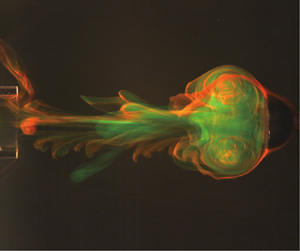Published online by Cambridge University Press: 18 September 2020

Motivated by the explosive launch of Sphagnum spores, this experimental study investigates how the vortices generated from two different sources, a piston–cylinder apparatus and a translating bluff body, interact with each other. While there have been numerous studies on the formation of a single vortex ring or multiple vortex rings, little is known about the effect of a translating bluff body on the formation of the coupled vortices. By varying the stroke ratio of the piston and the velocity ratio of the body to the piston, three distinct modes are identified for the mutual interaction between the starting jet from the piston and the wake from the cap: spill mode, attached mode and detached mode. The transitions between the vortex modes are predicted with simple analytical models. For the attached mode that appears at a velocity ratio intermediate between those of the spill mode and the detached mode, the merged flow structure becomes similar to a single vortex ring in the absence of the bluff body. By virtue of stable propagation following the cap, the vortex of the attached mode is capable of transporting a significant fluid volume initially inside the cylinder over a long distance, which shows its effectiveness in transport using a ballistic mechanism.